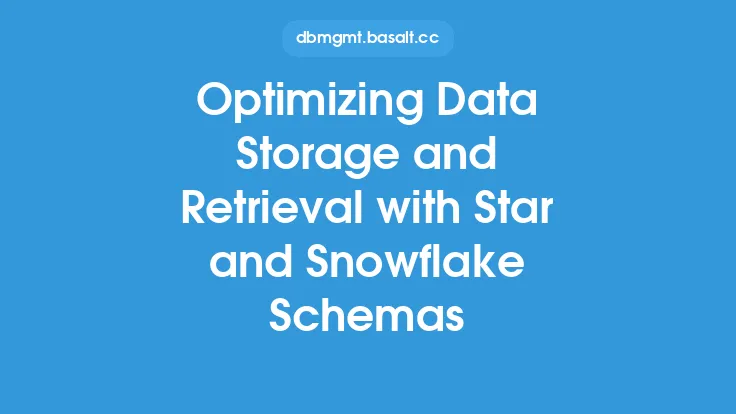Implementing star and snowflake schemas is a crucial aspect of data denormalization, as it enables improved data retrieval and query performance in data warehouses. To begin with, it's essential to understand the basics of star and snowflake schemas. A star schema is a database schema that consists of a central fact table surrounded by dimension tables. The fact table contains measurable data, while the dimension tables provide context to the data in the fact table. On the other hand, a snowflake schema is an extension of the star schema, where each dimension table is further normalized into multiple related tables.
Introduction to Star Schemas
A star schema is the simplest and most common type of data warehouse schema. It consists of a fact table that contains the primary data, and a set of dimension tables that provide additional information about the data in the fact table. The fact table is typically very large and contains a large number of rows, while the dimension tables are smaller and contain a limited number of rows. The star schema is ideal for data warehouses that require fast query performance and simple data retrieval.
Introduction to Snowflake Schemas
A snowflake schema is a more complex type of data warehouse schema that is designed to provide additional levels of detail and granularity. It consists of a fact table that is surrounded by multiple levels of dimension tables, each of which is further normalized into multiple related tables. The snowflake schema is ideal for data warehouses that require complex data analysis and detailed reporting.
Designing Star Schemas
Designing a star schema requires careful planning and consideration of the data requirements. The first step is to identify the fact table, which should contain the primary data. The next step is to identify the dimension tables, which should provide additional information about the data in the fact table. The dimension tables should be designed to provide a limited number of rows, and should be optimized for fast query performance. The fact table should be designed to contain a large number of rows, and should be optimized for fast data retrieval.
Designing Snowflake Schemas
Designing a snowflake schema is more complex than designing a star schema, as it requires multiple levels of dimension tables. The first step is to identify the fact table, which should contain the primary data. The next step is to identify the first level of dimension tables, which should provide additional information about the data in the fact table. Each dimension table should be further normalized into multiple related tables, which should provide additional levels of detail and granularity. The snowflake schema should be designed to provide fast query performance and complex data analysis.
Implementing Star and Snowflake Schemas
Implementing star and snowflake schemas requires careful consideration of the data requirements and the database design. The first step is to create the fact table, which should contain the primary data. The next step is to create the dimension tables, which should provide additional information about the data in the fact table. The dimension tables should be optimized for fast query performance, and should be designed to provide a limited number of rows. The fact table should be optimized for fast data retrieval, and should be designed to contain a large number of rows.
Optimizing Star and Snowflake Schemas
Optimizing star and snowflake schemas requires careful consideration of the data requirements and the database design. The first step is to optimize the fact table, which should contain the primary data. The fact table should be optimized for fast data retrieval, and should be designed to contain a large number of rows. The next step is to optimize the dimension tables, which should provide additional information about the data in the fact table. The dimension tables should be optimized for fast query performance, and should be designed to provide a limited number of rows.
Best Practices for Implementing Star and Snowflake Schemas
There are several best practices to follow when implementing star and snowflake schemas. The first best practice is to keep the fact table simple and focused on the primary data. The next best practice is to keep the dimension tables small and optimized for fast query performance. The third best practice is to use indexes and other optimization techniques to improve query performance. The fourth best practice is to use data partitioning and other techniques to improve data retrieval performance.
Common Challenges and Solutions
There are several common challenges and solutions to consider when implementing star and snowflake schemas. The first challenge is data complexity, which can make it difficult to design and implement the schema. The solution is to use data modeling and other techniques to simplify the data and improve the schema design. The next challenge is query performance, which can be slow if the schema is not optimized. The solution is to use indexes and other optimization techniques to improve query performance. The third challenge is data retrieval performance, which can be slow if the schema is not optimized. The solution is to use data partitioning and other techniques to improve data retrieval performance.
Conclusion
In conclusion, implementing star and snowflake schemas is a crucial aspect of data denormalization, as it enables improved data retrieval and query performance in data warehouses. By following best practices and using optimization techniques, it's possible to design and implement star and snowflake schemas that provide fast query performance and complex data analysis. Whether you're working with a simple star schema or a complex snowflake schema, the key is to keep the fact table simple and focused on the primary data, and to use indexes and other optimization techniques to improve query performance. With careful planning and consideration of the data requirements, it's possible to implement star and snowflake schemas that provide fast and efficient data retrieval and query performance.





